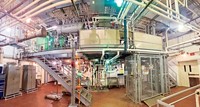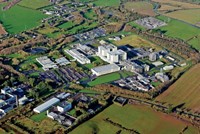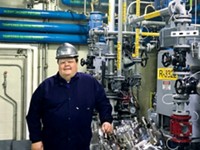Advertisement
Grab your lab coat. Let's get started
Welcome!
Welcome!
Create an account below to get 6 C&EN articles per month, receive newsletters and more - all free.
It seems this is your first time logging in online. Please enter the following information to continue.
As an ACS member you automatically get access to this site. All we need is few more details to create your reading experience.
Not you? Sign in with a different account.
Not you? Sign in with a different account.
ERROR 1
ERROR 1
ERROR 2
ERROR 2
ERROR 2
ERROR 2
ERROR 2
Password and Confirm password must match.
If you have an ACS member number, please enter it here so we can link this account to your membership. (optional)
ERROR 2
ACS values your privacy. By submitting your information, you are gaining access to C&EN and subscribing to our weekly newsletter. We use the information you provide to make your reading experience better, and we will never sell your data to third party members.
Business
AMRI confronts change, again
On the verge of going private, the drug services innovator sorts through a stream of acquisitions
by Rick Mullin
July 31, 2017
| A version of this story appeared in
Volume 95, Issue 31

“When we started our company in 1998, we studied AMRI,” recalls Greg Reid about American Advanced Organics, a contract research and custom synthesis firm he and other ex-Bristol-Myers Squibb researchers launched in Syracuse, N.Y.
AMRI at a glance
Business units (% revenue):
API and fine chemicals manufacturing—68%
Discovery, development, and analytical services—17%
Finished drug manufacturing—15%
▸ Revenue: $570 million
▸ Net income: –$70 million
▸ R&D spending: $16 million
▸ Employees: 3,100
▸ Acquisitions from 2014 to 2016: 7
▸ Generic drug codevelopment deals with royalty opportunities through 2020: 12
▸ Phase III manufacturing programs: 44
▸ Research and manufacturing sites in U.S., Europe, and India: 21
Note: Financial figures are for 2016.
Source: AMRI
AMRI, known formally as Albany Molecular Research Inc., had made a name for itself as a contract research organization. Indeed, its chief executive officer at the time, Thomas E. D’Ambra, was often called the innovator of the contract research organization (CRO) model in pharmaceuticals. “If we had to make a picture of what we thought we would be, we thought in five to 10 years we’d love to be AMRI,” Reid says.
The dream became reality two years later when AMRI acquired American Advanced Organics in an effort to bolster its chemical development service offering. Reid claims the Syracuse facility for AMRI, later moving to its headquarters to manage the chemical development division until his departure in 2004.
AMRI closed its Syracuse operation two years ago, refusing to sell it back to Reid, who now runs a one-man consultancy, ChemDev Solutions, near Boston. “They didn’t want to compete with us,” Reid says.
The story of the Syracuse facility is one of many tales of acquisition and operational change that characterized D’Ambra’s time at the helm of AMRI. Another round of acquisition and consolidation followed under William S. Marth, who took over as CEO in 2014.
That second series of maneuvers shifted the firm’s business mix toward pharmaceutical chemical manufacturing and culminated in June in a $1.5 billion deal with two investment firms, Carlyle Group and GTCR, to go private. Once again, AMRI finds itself herding a sprawl of activity into a recognizable business model while trying to explain to the outside world where it wants to go.
Founded in 1991 by D’Ambra, a former research chemist at Sterling Winthrop, AMRI developed a unique business of offering research services to drug companies, codeveloping active pharmaceutical ingredients (APIs), and advancing its own pipeline of drug candidates. After completing an initial public offering in 1999, AMRI went on to adapt its model to include commercial production of APIs, becoming a pioneer contract development and manufacturing organization (CDMO).
The company capped a cycle of rapid expansion with the 2010 acquisitions of Excelsyn, a British pharmaceutical chemical maker, and Hyaluron, a finished-dose drug formulator in Burlington, Mass. Then it stalled.
AMRI was already bracing for the loss of a big source of earnings: royalties from its discovery of a new route to fexofenadine, the API in the allergy medicine Allegra, which faced patent expiry. Then a U.S. Food & Drug Administration warning letter for its Burlington plant and an unfavorable arbitration ruling on a dispute with Borregaard Synthesis over a raw materials contract complicated the grim near-term outlook for the company.
D’Ambra assured investors that the pieces were in place to put AMRI on a growth track within a year. But there were questions about how all the pieces fit together and whether they were in the right place. Some analysts, for example, wondered why the company had chosen Singapore as an alternative to China for research services in Asia when it also had labs in India.
At the end of 2013, D’Ambra, who is now chair of AMRI’s board, passed the reins to Marth, who had joined the board in 2012. Marth, former head of Teva Pharmaceutical Industries’ Americas operations, soon began combining pieces. He also took several off the table, including the Syracuse plant and the Singapore R&D center, both of which he closed.
Meanwhile, AMRI launched a new wave of acquisitions—seven between 2014 and 2016—and established a research center in Buffalo by becoming an anchor tenant of a biotech hub sponsored by the state of New York. But the growth has yet to bring profits. The company posted a $70 million loss last year, due largely to the cumulative impact of so many acquisitions and loss of the fexofenadine royalties.
Marth acknowledges that a significant transformation has taken place at AMRI under his leadership—three years in which the company’s revenue more than doubled to $570 million in 2016, primarily through growth in manufacturing.
“The difference between 2010 and now is stark,” he says. On the other hand, D’Ambra’s innovation in pharmaceutical services established a base from which to grow, he says.
But Marth and his team wanted to push services further into the downstream part of their customers’ drug development process. “We felt from our experience at Teva that we could build a robust API business that could serve the needs of brands as well as generics,” he says.
“What we didn’t want to do was produce a lot of white powder,” he says, referring to easy-to-synthesize products. His target was difficult chemistry.
In 2014, AMRI acquired Wisconsin-based Cedarburg Pharmaceuticals, a specialist in low-volume controlled substance and steroid APIs. The company also built on the small injectable drug business in Burlington with the acquisitions of Oso Biopharmaceuticals Manufacturing in Albuquerque, N.M., and an Aptuit business in Glasgow, Scotland.
The big moves in APIs came with the acquisitions of Spain’s Gadea Biopharma in 2015 and Italy’s Euticals last year. Gadea brought a $90 million-per-year business in APIs for both branded and generic drugs. With about $250 million in annual sales, Euticals operates several sites, including API production facilities in Italy, France, and Springfield, Mo., and a chemical development center in Frankfurt.
With its latest moves, AMRI has grown its API business to about 65% of sales. Marth estimates that about 60% of its API production is for customers’ generic drugs and 40% for their more profitable branded drugs. He’d like to strike a 50-50 balance.
The company has a long-range goal of growing its API business to $750 million in annual sales. For finished drugs, the target is $500 million; for drug discovery and development services, it’s $200 million to $250 million.
AMRI forecasts revenue of $725 million for 2017 and aims to cross the $1 billion line next year. Although acquisition has fueled much of the growth until now, Marth points out that AMRI has been posting organic growth of approximately 8% per year.
Assessing the company’s evolution through the latest run of acquisitions, Christopher Conway, senior vice president of drug discovery, chemical development, and analytical services, points to specialization. “In discovery and development, for many years we kind of got into everything,” says Conway, a former marketing manager at Johnson & Johnson. “When Bill [Marth]came in a few years ago, we focused our business on very specific high-barrier-to-entry areas.”
The company’s immediate concern going forward, according to Marth and Conway, is to put all the new pieces in place. But future acquisitions are not out of the question.
Marth says the company will have to add biologics API manufacturing at some point as drugs in that pipeline move forward. And Conway points to a “gap in drug discovery” in Europe, given that AMRI operates major labs in Buffalo and India.
James Bruno, managing director of the consulting firm Chemical & Pharmaceutical Solutions, raises the question of whether AMRI’s financial buyers will seek an exit strategy that breaks the company up. In his view, AMRI has had a history of acquiring haphazardly. “And they never pulled it together,” he says. “I am not sure where they are going. I wouldn’t be surprised if [the new owners] started taking it apart piece by piece.”
Marth and Conway counter that Carlyle and GTCR back AMRI’s growth strategy and its goal of establishing end-to-end research and manufacturing services focused on high-end science. Achieving that goal, however, will depend on customers’ ability to recognize AMRI’s business model, one that Reid of ChemDev Solutions sees veering toward supplying generic APIs. “Going from CRO to CDMO to generic drug company, they end up with pieces that are no longer part of their core activities,” Reid says. “I still don’t understand why they shut down the Syracuse site. They could have made a lot of money.”





Join the conversation
Contact the reporter
Submit a Letter to the Editor for publication
Engage with us on Twitter